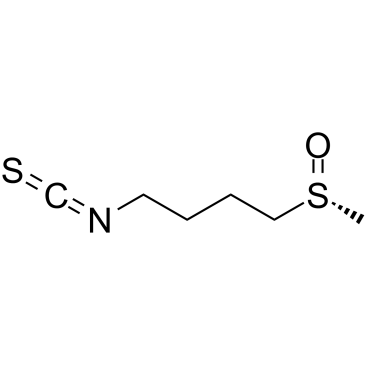L-Sulforaphane

L-Sulforaphane structure
|
Common Name | L-Sulforaphane | ||
|---|---|---|---|---|
| CAS Number | 142825-10-3 | Molecular Weight | 177.288 | |
| Density | 1.2±0.1 g/cm3 | Boiling Point | 368.2±25.0 °C at 760 mmHg | |
| Molecular Formula | C6H11NOS2 | Melting Point | N/A | |
| MSDS | USA | Flash Point | 176.5±23.2 °C | |
|
Sulforaphane prevents doxorubicin-induced oxidative stress and cell death in rat H9c2 cells.
Int. J. Mol. Med. 36 , 53-64, (2015) Sulforaphane, a natural isothiocyanate compound found in cruciferous vegetables, has been shown to exert cardioprotective effects during ischemic heart injury. However, the effects of sulforaphane on cardiotoxicity induced by doxorubicin are unknown. Thus, in... |
|
|
In vitro metabolic conversion of the organic breakdown products of glucosinolate to goitrogenic thiocyanate anion.
J. Sci. Food Agric. 95 , 2244-51, (2015) Glucosinolates are abundant in Brassicaceae vegetables, and they are degraded into various organic breakdown products (BPs) (R-CN, -NCS and -SCN) by myrosinase when plant tissues are damaged. This study was designed to investigate whether these BPs could be b... |
|
|
Nrf2 Activation Promotes Keratinocyte Survival during Early Skin Carcinogenesis via Metabolic Alterations.
Cancer Res. 75 , 4817-29, (2015) Pharmacologic activation of the transcription factor NRF2 has been suggested to offer a strategy for cancer prevention. In this study, we present evidence from murine tumorigenesis experiments suggesting there may be limitations to this possibility, based on ... |
|
|
Pyrrole alkaloids with potential cancer chemopreventive activity isolated from a goji berry-contaminated commercial sample of African mango.
J. Agric. Food Chem. 62(22) , 5054-60, (2014) Bioassay-guided fractionation of a commercial sample of African mango (Irvingia gabonensis) that was later shown to be contaminated with goji berry (Lycium sp.) led to the isolation of a new pyrrole alkaloid, methyl 2-[2-formyl-5-(hydroxymethyl)-1H-pyrrol-1-y... |
|
|
The anthraquinone derivative Emodin inhibits angiogenesis and metastasis through downregulating Runx2 activity in breast cancer.
Int. J. Oncol. 46(4) , 1619-28, (2015) Emodin (EMD) is an anthraquinone derivative extracted from the root and rhizome of Rheum palmatum L. which exhibits a range of activities, including anti-bacterial, antitumor, diuretic and vasorelaxant effects. The ability to inhibit metastasis and angiogenes... |
|
|
Identification of Ginkgo biloba as a novel activator of pregnane X receptor.
Drug Metab. Dispos. 36(11) , 2270-6, (2008) Pregnane X receptor (PXR; NR1I2) is a ligand-activated transcription factor that plays a role not only in drug metabolism and transport but also in various other biological processes. Ginkgo biloba is a herbal medicine commonly used to manage memory impairmen... |
|
|
Sulforaphane protects astrocytes against oxidative stress and delayed death caused by oxygen and glucose deprivation.
Glia 57(6) , 645-56, (2009) Oxidative stress is an important molecular mechanism of astrocyte injury and death following ischemia/reperfusion and may be an effective target of intervention. One therapeutic strategy for detoxifying the many different reactive oxygen and nitrogen species ... |
|
|
Separation and purification of sulforaphane from broccoli by solid phase extraction.
Int. J. Mol. Sci. 12 , 1854-61, (2011) A simple solid-phase extraction (SPE) method for the determination of sulforaphane in broccoli has been developed. The optimal conditions were found to be use of a silica SPE cartridge, and ethyl acetate and dichloromethane as washing and eluting solvents, re... |
|
|
A major inducer of anticarcinogenic protective enzymes from broccoli: isolation and elucidation of structure.
Proc. Natl. Acad. Sci. U. S. A. 89 , 2399-2403, (1992) Consumption of vegetables, especially crucifers, reduces the risk of developing cancer. Although the mechanisms of this protection are unclear, feeding of vegetables induces enzymes of xenobiotic metabolism and thereby accelerates the metabolic disposal of xe... |
|
|
Sulforaphane-induced cell death in human prostate cancer cells is initiated by reactive oxygen species.
J. Biol. Chem. 280(20) , 19911-24, (2005) We have shown previously that sulforaphane (SFN), a constituent of many edible cruciferous vegetables including broccoli, suppresses growth of prostate cancer cells in culture as well as in vivo by causing apoptosis, but the sequence of events leading to cell... |